Huawei Mate 20 Review
Huawei Mate 20 Review
An awesome 'all screen' phone
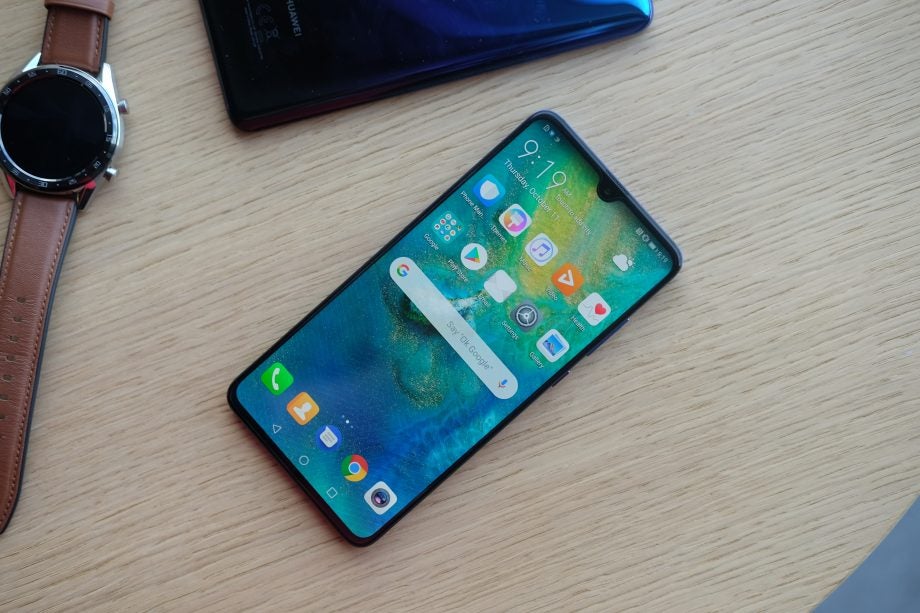
Verdict
The Huawei Mate 20 offers lightning-fast performance and a comprehensive list of features, with a clever bill of compromises to help meet its £500 price tag. It’s a genuine OnePlus 6T rival.
Pros
- Great performance
- Fully featured camera
- Tidy notched design
Cons
- EMUI is a bit ugly
- Facial recognition isn’t secure
- Too many gimmicky camera modes
Key Specifications
- Review Price: £499
- 6.5-inch FHD+ display with 'Dewdrop' notch
- Kirin 980
- three cameras on the back
- 4000 mAh battery
What is the Huawei Mate 20?
The Huawei Mate 20 slots into an intriguing new area of the smartphone market: the entry-level flagship. In a market where out-and-out flagship phones now cost around £1000 (thanks, Apple), phones such as the OnePlus 6T and the Xiaomi Mi 8 Pro are filling the vacuum.
Just like those phones, the Huawei Mate 20 offers high-end core components and a largely premium experience for around half the price of big-hitters such as the iPhone XS, the Samsung Galaxy Note 9 and, indeed, the Huawei Mate 20 Pro.
The £499 Huawei Mate 20 strips out some of the more extravagant features of its big brother, such as its ability to charge other phones wirelessly and its in-display fingerprint scanner. What’s left is a very good all-rounder with precious few meaningful flaws – and a few eye-catching tricks of its own.
Editors Note: Due to the recent retraction of Huawei’s Android license, future Huawei and Honor phones won’t be able to access Google Play Services and as a result many Android apps including YouTube and Gmail. Both Huawei and Google have confirmed Huawei and Honor phones, like the one in this review, will continue to have access for this time being. Until we know more about the situation we’re leaving the scores on all our Huawei reviews, however as the situation changes we’ll revisit this.
Related: Huawei Mate 30
Huawei Mate 20 – Design
Huawei’s design work seems to improve by the year. After the downright attractive Mate 20 Pro (which we called “Huawei’s best-looking phone yet” in our review), the Huawei Mate 20 packs a little less of a visual wallop. But it’s a decent-looking piece of kit nonetheless.
Our review model comes in a sober yet smooth and shiny black, with a highly reflective glass rear. But you can also grab the Mate 20 in a couple of funkier colours that play cool tricks with light and texture.
This is quite a heavy phone at 188g, but it doesn’t feel unduly hefty. It seems to spread its weight evenly over a fairly large surface area of 158.2 x 77.2mm.
Related: Best smartphones
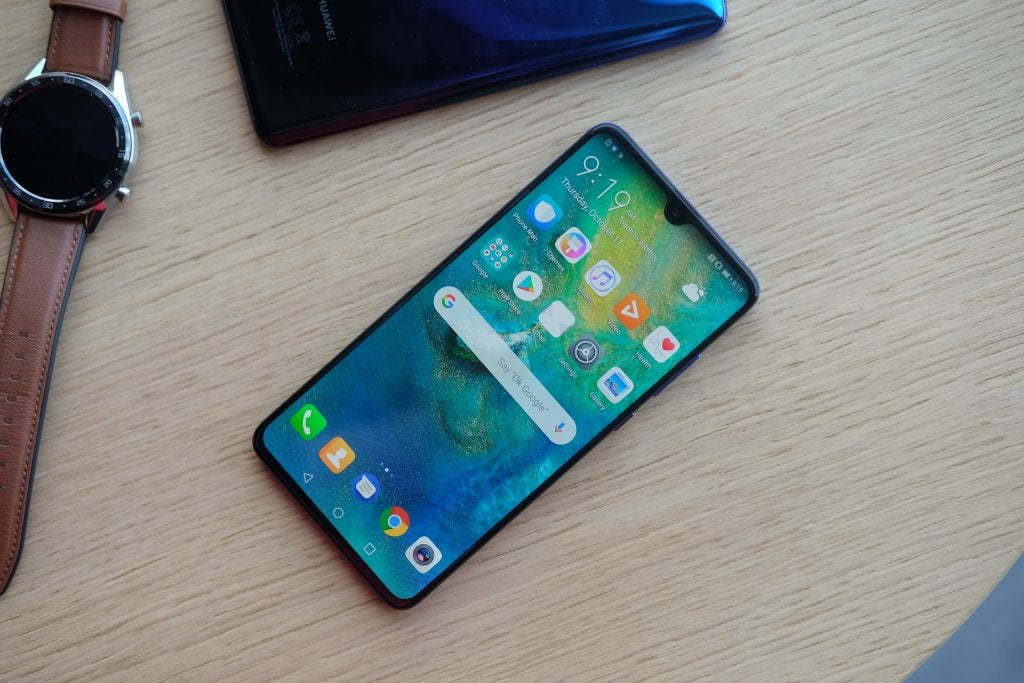
Indeed, the Huawei Mate 20 is a less dainty phone than the Mate 20 Pro. You don’t get the same curve-away screen edges here, which helped that phone feel much smaller than it was. However, you do get a similarly eye-catching, red-rimmed power button, which adds a welcome dash of colour.
One way in which the Mate 20 actually beats its pricier sibling in the looks department is with the appearance of its notch. This is a much smaller, teardrop-shaped example than the elongated bar of its big brother. It’s more OnePlus 6T than iPhone XS and, alongside minimal bezels, it contributes to an 88% screen to body ratio.
While I’d argue that it’s easier on the eye, this smaller notch also means that the facial recognition system on the Mate 20 is significantly less sophisticated and secure than on the Mate 20 Pro. It’s speedy enough, but it doesn’t map your facial features with anything like the same level of elegance.
If security is your primary concern here, I’d recommend sticking with the built-in fingerprint authentication. Again, this differs from the Mate 20 Pro’s implementation. Whereas the Pro goes with a fancy new in-display sensor, the Mate 20 sticks with a tried-and-tested stand-alone unit that sits just below the rear camera.
It isn’t going to impress your friends as much, and it means you can’t unlock your phone while it’s resting on a table. But it’s actually faster and more reliable than the flashier alternative.
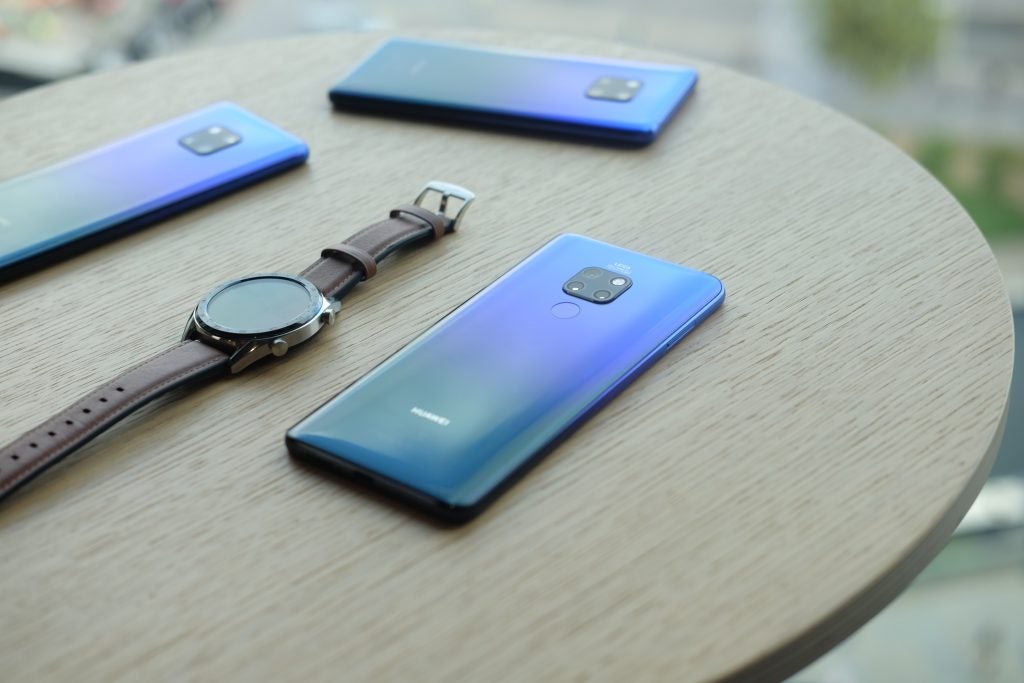
One notable feature the Mate 20 has that the Mate 20 Pro doesn’t is a headphone jack. It’s positioned right there on the top of the phone. This perhaps contributes to an inferior IP53 water- and dust-resistance rating (the Pro is IP68-rated), but to some that will doubtless be a worthwhile compromise.
On the opposite end of the phone you get a standard USB-C port, which is what you’d expect of a handset at this time and price point.
Huawei Mate 20 – Display
The Huawei Mate 20 packs a 6.53-inch IPS LCD display with a stretched-out 18.7:9 aspect ratio. It isn’t all that sharp by modern standards, though.
At just 2244 x 1080, it’s good for a mere 388ppi, which pales next to the QHD/538ppi output of the Mate 20 Pro. Indeed, with the switch from the latter’s brilliant AMOLED to LCD technology, this arguably represents the biggest quality gap between the two phones.
It would be misleading to read too much into those specs and conclude that the Mate 20 screen is a poor one, though. This just isn’t the case. It’s an expansive, bright (to the tune of 820 nits), accurate LCD screen that really shows off video and gaming content well – something that’s only enhanced by the presence of stereo speakers.
The iPhone XR recently demonstrated that you don’t have to have a pixel-dense AMOLED to produce pleasing visual results, and the Huawei Mate 20 backs up that view. It even sports HDR10 support.
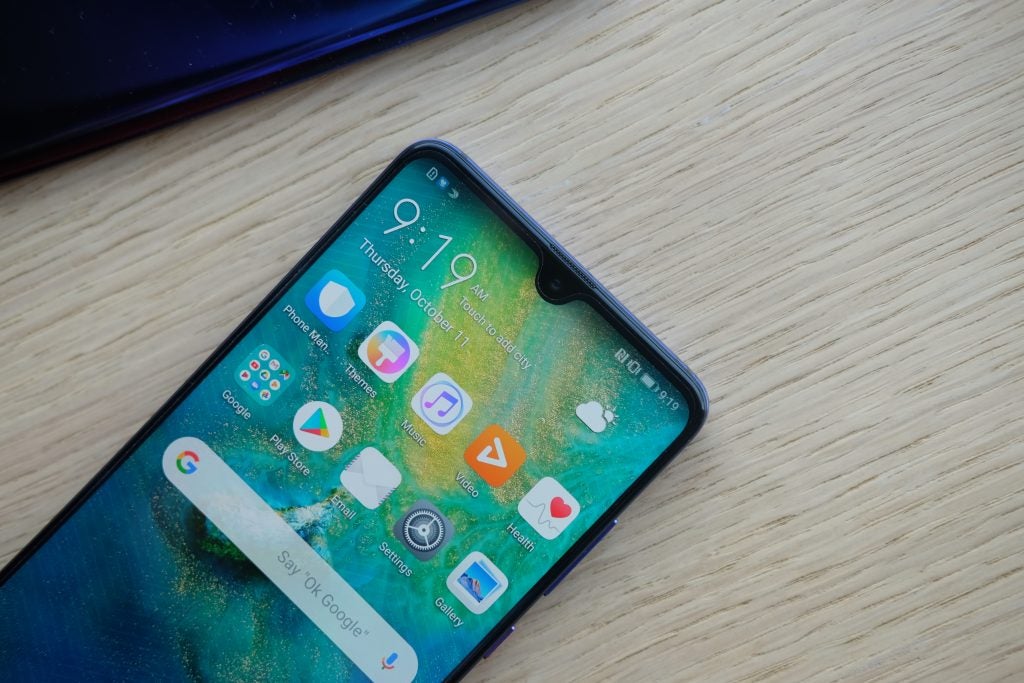
Going back to the notch for a second, it’s one of the least intrusive examples you’ll find. Whether video content zooms in and incorporates it or cuts it out of the equation, there isn’t the same hampered feeling that you get with larger iPhone X-influenced notches.
There’s an option to permanently hide the notch with a black bar in the Settings menu, although this somehow makes the display seem even less symmetrical. What’s more, without the benefit of AMOLED’s blacker-than-black nature, you can still see the notch a little.
Huawei Mate 20 – Performance
In performance terms, the Huawei Mate 20 is unimpeachable. Just like the Mate 20 Pro, it runs on the company’s own Kirin 980 CPU coupled with 6GB of RAM (a 4GB model is also available).
This Kirin 980 might not be as widely used as the Snapdragon 845 found in most other 2018 flagships, but it appears to be faster. The chip is built using the same 7nm architecture behind Apple’s current A12 monster, which powers the peerless iPhone XS. This compares favourably to the larger and less-efficient 10nm process behind the aforementioned Snapdragon 845.
Sure enough, the Huawei Mate 20 outperformed its Android rivals in our Geekbench 4 benchmark tests with a monstrous multi-core score of 9714, and a similarly impressive single-core score of 3307.
By way of a comparison, the OnePlus 6T – arguably the fastest of the 2018 Snapdragon 845 brigade – scored 8915 and 2407 respectively. The Samsung Galaxy S9 Plus and its custom Exynos chip pipped the Huawei Mate 20 on single-core performance (3720), but lagged well behind on multi-core (8890).
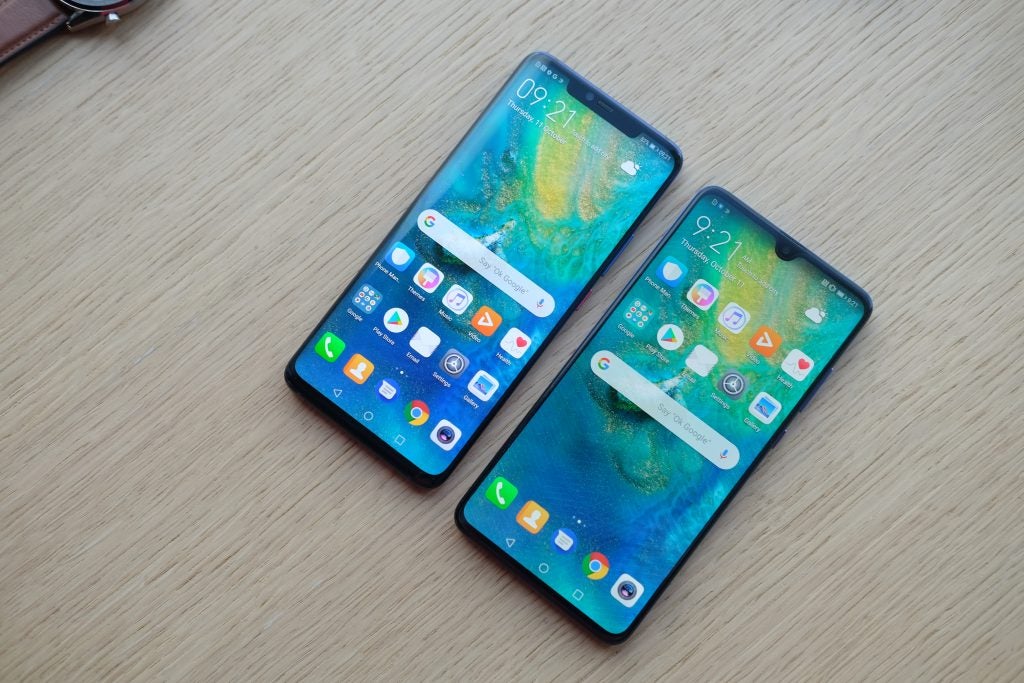
Even the Huawei Mate 20 Pro, with its more demanding QHD display, comes up a little way short of the Mate 20 on 9493 multi-core and 3242 single-core. Basically, we’re looking at the new Android performance champ here.
That’s certainly consistent with my real-world experience. In general navigation, the Mate 20 didn’t put a foot wrong. Multi-tasking, waking from sleep, jumping into the camera app from the lock-screen – all were executed without a hitch.
Of course, for £500 you’d expect this as a bare minimum. But the Huawei Mate 20 is similarly imperious in advanced tasks such as gaming. Infamous system hogs Asphalt 9 and PUBG ran flawlessly on High graphics settings. This phone is a beast.
Huawei Mate 20 – Software
In hardware terms, we’ve seen that the Huawei Mate 20 is tough to knock. But, as always with Huawei phones, the software experience is decidedly easier in which to pick holes.
That’s because Huawei insists on offering its own heavily customised UI on top of Google’s Android OS. It isn’t alone in this practice. In fact, most Android manufacturers do this to some extent. But Huawei’s is far from the best of the bunch.
It remains a curiously half-baked mish-mash of concepts taken from Apple’s iOS and Android itself. The style is both inconsistent and clumsy, with basic app icons and menus, and a curiously restrictive lock-screen.
You also get a handful of ugly, largely superfluous apps for Music, Video, Health, Calendar and the like. With Google providing superior versions of all, there really is little incentive to delve too far into them. The Themes app is an ever-present on EMUI, allowing you to customise the look of your homescreen. If only most of the alternatives didn’t look so cheap…
While I’m still not a fan of EMUI, at least recent versions have been smooth, fast and reliable – even on relatively modest hardware. Here, on the Huawei Mate 20 – with its powerful processor, oodles of RAM, and with Android 9.0 Pie pulling the strings behind the scenes – it actually feels pretty great.
It even lets Android shine through a little. You can still access the Google Feed by swiping to the left of the homescreen, while Google Assistant can be found with a long press of the virtual home button or through an ‘OK Google’ vocal prompt.
Huawei has cleaned up its EMUI act significantly, and the divisive UI runs flawlessly here on the Huawei Mate 20. It isn’t a pain to live with, by any means. But it’s also well short of the brilliant stock Android experience, which is a shame.
Huawei Mate 20 – Camera
While the Huawei Mate 20 isn’t the first phone to pack in three rear cameras, it still remains a head-turning novelty. Just like the Huawei Mate 20 Pro before it, the Mate 20 packs in one wide, one ultrawide, and one telephoto lens.
What this means in layman’s terms is that you can switch between a “normal” camera view, a slightly zoomed-out and expansive camera view, and a slightly zoomed-in camera view. They’ll also work together to provide features such as enhanced depth-of-field effects and a whole host of extra modes of varying utility.
From an exterior design perspective, I’m far more of a fan of Huawei’s positioning of these three cameras in a square cluster than Samsung’s four-strong lineup with the Galaxy A9. I’m still not convinced that this is the most efficient or effective way to improve mobile photography, though.
Arguably the best smartphone camera in the business – the Google Pixel 3 – does wonderful stuff with just a single camera, after all. That said, the Mate 20 Pro camera proves to be a strong and flexible operator, so there’s clearly something to be said for the brute-force approach.
I found the Huawei Mate 20 camera to be capable in most situations, although it isn’t up there with its big brother or the rest of the top tier. Its primary camera actually packs in a good deal fewer megapixels than the Mate 20 Pro (12 megapixels versus 40 megapixels), and it doesn’t benefit from the “pixel-binning” technique that produced such refined 10-megapixel pictures in the Pro. But the images I captured on the Mate 20 in decent lighting still popped with colour and reasonable detail, for the most part.
If you want more fuss-free shots, with sophisticated scene selection and automated HDR, you’ll want to flick on the Master AI mode in the Camera Settings menu. This seemed to be set to the “off” position by default for me, which was a little strange.
When activated, it will use the Kirin 980’s dual neural engines to read the scene and change the camera’s settings accordingly. For example, it will quickly and reliably read human faces and switch to Portrait mode for close-ups. It will also bring in the ultrawide camera for sweeping landscape shots.
Things inevitably become noisier in lower lighting, and that’s especially noticeable when you switch to the 16-megapixel ultrawide or telephoto cameras. You can probably blame the lesser f/2.2 and f/2.4 apertures for that, with the main camera’s f/1.8 aperture letting way more light in and producing some pleasing results.
Related: Best camera phones
For really dark shots Huawei has included a Night mode, which asks you to hold the handset very still for several seconds. It then proceeds to take multiple shots at various exposure levels, and combines them intelligently as a way of brightening the shots whilst minimising the effects of hand-shake.
The result is undoubtedly brighter, clearer night-time shots, although this brightness also seems to draw attention to excess noise and a general sense of fuzziness. Any movement within the shot will also be picked up on, while very bright elements such as lights can tend to appear blown-out. It can be great if the scene and your subject are perfectly still, though.
Aperture mode is also included here, which lets you take close-up shots and adjust the background ”bokeh” effect after the shot has been taken. As always, the extremes of this aperture slider aren’t really worth using – too much of the subject gets lost in blur with a very wide aperture setting, while the opposite end of the scale renders the whole exercise rather pointless. Somewhere in the middle can yield quite pleasing results, though, if you’re careful with your framing.
Portrait mode does similar bokeh-enhancing things with the human face, but it also adds some dodgy beauty enhancements. It’s best left well alone.
You can also force a dedicated HDR mode for for those situations with extreme variances of light and shade, although I found this to be a little awkward to access within the camera interface. You can probably thank Huawei’s “everything but the kitchen sink” approach to camera features for that, but this mode in particular should probably have been given a more prominent position in the UI, or else fully integrated with the standard shooting mode.
A small mention should probably be made of AR Lens, which is Huawei’s attempt to emulate Apple’s Animoji. It enables you to overlay an animated cartoon head on your own and record the results. Some people will find it a fun gimmick to play around with for a few minutes, but the facial tracking and general execution isn’t as sharp or nuanced as Apple’s – and, ultimately, it’s more fat that could and perhaps should have been trimmed.

The top end of the Aperture mode slider is pretty much pointless

At the lower end of the Aperture mode slider, the blue becomes a little intrusive

In general images look sharp and natural, while colours pop

The Huawei Mate 20 offers good close-up/macro potential

Again, colours pop without looking unnatural

Decent detail given how full of texture this shot is

Night-mode
Huawei Mate 20 – Battery life
You get a 4000mAh battery powering the Huawei Mate 20, which is pretty darned large. The OnePlus 6T, by comparison, only has a 3700mAh battery, while the Xiaomi Mi 8 Pro gets by with a tiny 3000mAh unit.
It isn’t quite as big as the 4200mAh unit powering the Huawei Mate 20 Pro. But then that phone has to power a more pixel-dense display, so it probably evens out.
Scratch that: it definitely evens out. As our review found with its brother, I was able to get through a full two days of light to moderate usage quite regularly with the Huawei Mate 20.
I complained about EMUI and Huawei’s needless software tweaks a little earlier, but one thing I should really praise Huawei for is its attention to power-saving methods. The phone will largely take care of itself, but you can also take matters into your own hands.
There are two levels of battery-saving to choose from, which can drastically extend the phone’s life. You can also get a summary of all the ways in which you could conceivably eke more life out of the phone’s current setup – be that closing a power-sapping app or turning off GPS.
The display, meanwhile, is set to automatically downgrade the resolution where possible, saving more juice. Naturally, you can force this mode on, thus switching the display to 720p, or else switch it off altogether.
Conversely, there’s an optional Performance mode if you want to throw caution to the wind and crank that Kirin 980 up to max. You know you want to.
Even without such tinkering, I was able to achieve great results with the Huawei Mate 20’s battery. My usual test of running Guns of Boom for 15 minutes at half screen brightness lost consumed just 3% of the phone’s power. That’s two to three per cent better than many other phones I’ve used in 2018.
Why buy the Huawei Mate 20?
The Huawei Mate 20 is a strong option at the emerging £500 “almost-flagship” end of the market.
It sports an attractive design, some of the best performance we’ve seen from an Android phone at any price, and a decent triple-camera setup that offers bags of shooting options. Exemplary battery life will see more moderate users through two full days of usage, too.
Meanwhile the Mate 20’s large, edge-to-edge screen impresses, despite lacking the pop and precision of its Pro brother. We actually prefer its more subtle, teardrop-shaped notch.
Huawei’s custom EMUI skin continues to be an irritating “but” at the end of all our hardware praise, but the sheer strength – and speed – of the overall package makes it easier than ever to live with.
There are an increasing number of compelling options at this price point, not least the OnePlus 6T. But the Huawei Mate 20 is well equipped for the fight.
Verdict
The Huawei Mate 20 offers lightning-fast performance and a comprehensive list of features, with a clever bill of compromises to help meet its £500 price tag. It’s a genuine OnePlus 6T rival.
How we test phones
We test every mobile phone we review thoroughly. We use industry standard tests to compare features properly and we use the phone as our main device over the review period. We’ll always tell you what we find and we never, ever, accept money to review a product.
Trusted Score
Score in detail
-
Performance 10
-
Battery Life 10
-
Value 8
-
Software 6
-
Calls & Sound 8
-
Screen Quality 9


